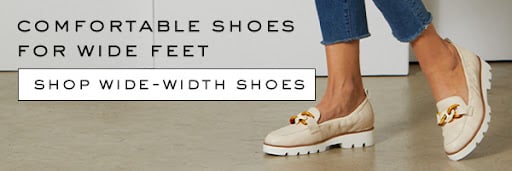
Whether you’ve been struggling to find comfortable shoes since your childhood or your fitting fights are more recent, it can be difficult for people with wide feet to meet their footwear needs.
But finding the perfect wide-width shoes isn’t the only challenge facing people with wider feet—and if you’re looking for wide feet solutions, you’ve come to the right place.
In this guide, we’re exploring everything you need to know about having wide feet: the causes, some challenges you might face if you have them, and tips that can help you overcome them.
Looking for solutions to your wide feet problems? Read on to discover future comfort.
Understanding Wide Feet
Anyone who has struggled with wide feet problems has likely wondered, “Why do I have wide feet in the first place?”
There are several reasons why people develop wide feet:
- Genetics
- Aging
- Pregnancy
- Unique foot features (and compensating for them)
- Improper footwear
- Swelling
- Injuries
In some cases, people are born with wide feet—and if you have a long history of struggling to find comfortable shoes, you may be one of these people. But in other cases, wide feet can develop later in life as a result of physical changes or a medical condition.
Another dark horse culprit of wide feet is low-quality footwear or shoes that simply aren’t right for your feet. If you have (or had) high arches, for instance, you need shoes with ample arch support. If your arches aren’t properly supported, they could relax with time, slowly widening your feet and causing a condition called Pes Planus.
Unique Foot Features
The list above mentioned unique foot features as a potential cause for foot widening. If your feet have any of these characteristics, you may have changed your footwear choices or even your gait to try to find comfort:
- Hammertoe
- Crossover toe
- Bunions
- Calluses
If you have a bunion, for instance, you might have inadvertently put pressure on other areas of your feet while you walk or stand to prevent foot pain and soreness in the bunion area. These changes to your gait could have impacted the structure of your foot, potentially causing one or both to widen.
While any foot condition causing significant pain should be examined by a doctor, some (like calluses) can be simply genetic. Learning to live with these unique features (or with wide feet in general) can be difficult, but we’ll discuss some potential solutions below.
First, Do You Have Wide Feet?
If you’re in pain or have trouble finding proper footwear, consider the possibility that your feet are wider than average. Determining whether or not your feet are, in fact, wide is the first step to finding relief.
You’ll need a few tools to determine your foot width:
- A piece of paper bigger than your foot
- A pen or pencil
- A ruler or measuring tape
Stand on top of the piece of paper and trace your foot; then use the measuring tape to take both a length and width measurement:
- The length measurement is the distance between the end of your longest toe and your heel.
- The width measurement is the distance from one side of your foot to the other at the widest point—for many, this is the toe box area, but that’s not always the case.
Once you have your measurements, take a look at a few size charts for various shoe brands. It’s important to remember that length and width are relative; so, a 3.75-inch width for a pair of size 5 shoes might be wider than average, but this width wouldn’t be unusual for a standard size 8 or 9.
If your foot width exceeds the widths of standard sizes, you might be a good match for wide-width shoes.
3 Wide Foot Challenges (and Solutions!)
Whether you’re adjusting to having wide feet during pregnancy or you’ve had wide feet your entire life, you may experience some not-so-comfortable struggles. Let’s explore some of these in detail—and provide wide feet solutions that can help you unlock comfort.
#1 Difficulty Finding Shoes
If you’ve had difficulty finding shoes that don’t suffocate your feet, you’re not alone. This is one of the most common challenges among people with wide feet.
Settling for a pair of uncomfortable or poor-fitting shoes doesn’t just impact your everyday comfort; it can also affect your health. Just like wearing shoes with poor arch support can contribute to Pes Planus (collapsed arches), wearing shoes that are too tight can cause foot pain and swelling.
Solution: Expand Your Search
If you’re frustrated by your search for comfortable footwear you should ask yourself, “Do I need wide shoes?” Here are some tips and tricks for finding your new favorite kicks:
- Ditch narrow brands – Many shoe brands simply don’t make wide-width shoes. Since many people don’t even know the difference between wide vs regular shoes, demand is sometimes too low for brands to make every design and size in a wide width. Your first step is to find a brand that does carry wide sizes.
- Measure your feet for the perfect fit – If you’ve never measured your feet before (or it’s been a while), consider doing so. Use these measurements to closely review shoe size charts (if you’re shopping online) or show them to a sales associate at a retail store to find a pair of shoes that actually fits.
- Remember what to look for in shoe sizing – When you get to trying on different options of cute shoes for wide feet, you should be able to comfortably wiggle your toes—they shouldn’t feel confined or numb. The end of your shoe should just touch the end of your longest toe, and your heel should sit comfortably inside the shoe. While shoes will stretch as you break them in, don’t expect initial comfort issues to resolve themselves: if you can’t move your toes or walk comfortably, you need a bigger size.
#2 Discomfort While Walking or Standing
While not all people with wide feet are in pain, there are a few reasons why walking or standing might be uncomfortable for many:
- Poor support – Whether your arches are high or low, poor arch support can cause discomfort and even contribute to foot widening.
- Other foot and ankle issues – If you’ve adjusted your gait pattern to compensate for ankle discomfort, foot issues (like swelling, weakness, or injury), or for pain caused by improper footwear, these adjustments might lead to further soreness or injury.
- Small shoes – If your shoes are too small to accommodate the full width of your foot, they could be causing constriction—or, perhaps your feet are “spilling” over the sole. Either situation can cause discomfort, especially while walking or standing.
Solution: Consult with the Pros
If you have difficulty standing or walking, you should consider seeing a professional, like a(n):
- Podiatrist, who treats issues associated with feet, ankles, and legs.
- Orthopedist, who treats joints, bones, nerves, and tendons throughout the body.
These healthcare experts are also highly qualified to help people with wide feet suffering from plantar fasciitis, heel spurs, Morton’s neuroma, and other painful foot conditions.
You could also speak to a health professional about trying orthotic or highly supportive shoes. A provider specializing in foot or leg care might be able to recommend proper footwear uniquely suited to your body, gait, or foot size—and a pair of high-quality shoes could be the key to unlocking more everyday comfort while walking or standing.
#3 Footwear Concerns
If your wide feet impact various aspects of your everyday life (like your ability to walk comfortably or find shoes that fit properly), you might feel a degree of concern about these challenges.
While this sense of unease is perfectly normal, remember that you don’t have anything to be embarrassed about. We can’t control our foot shape, and it can take time to recover from injuries or conditions that can change our gait, comfort level, or foot appearance. And, rest assured—you’re not alone.
Solution: Explore Flattering Footwear
If you’re looking for a confidence boost, consider the power of a comfortable, stylish, and supportive pair of shoes:
- They’ll increase walking comfort – A pair of shoes that fit correctly could literally put some pep in your step. With ample support and a sole wide enough to accommodate your whole foot, you can improve your gait and walk confidently again.
- They’ll make your feet look smaller – It might sound counterintuitive, but for people with wider-than-average feet, wide-width shoes can actually make their feet look narrower. The concept is similar to wearing tight-fitting clothes vs. loose-fitting ones: shoes that fit draw less attention than shoes that are obviously too small.
In addition, some shoe styles have the added benefit of making wide feet look smaller, particularly:
These styles draw attention to the heel instead of the toe box (the latter typically being the widest part of the foot).
Discover Style and Comfort in Vionic’s Wide Shoes
If wide-foot problems are taking their toll, it’s time to discover real solutions that will increase your comfort and confidence. One of the best wide-feet solutions is simply finding a high-quality, stylish pair of wide-width shoes.
Vionic understands that, in shoe departments, comfort often comes at the expense of style—but we’re breaking that mold. Our collection of heels, loafers, sandals, and active shoes offers high-quality comfort without sacrificing aesthetics.
Say goodbye to ill-fitting, low-support shoes and discover the future of footwear with Vionic. Explore the collection now.
Sources:
- Raj, Marc et al. “Pes Planus.” National Library of Medicine.https://www.ncbi.nlm.nih.gov/books/NBK430802/
- “What Is a Podiatrist?” American Podiatric Medical Association. https://www.apma.org/podiatristsFAQ
- “What Is an Orthopedic Doctor?” University of Utah. https://healthcare.utah.edu/orthopaedics/specialties/what-is-orthopedic-doctor


Leave a Reply